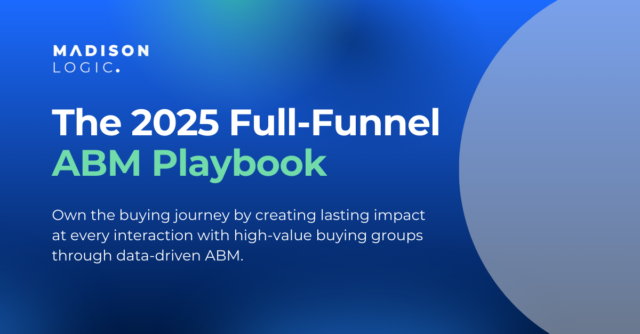
B2B buying is a team effort that marketers cannot afford to overlook. According to Gartner, a typical buying committee for a complex B2B solution consists of six to ten decision-makers, each armed with their own set of four or five independently gathered pieces of information. When the committee comes together, they must share and align their research to make a unanimous purchase decision. It’s a collaborative process that ensures everyone’s insights are considered, leading to a unified choice.
Marketers must engage with multiple buying committee members rather than relying on just one lead source to succeed. In this article, we’ll explore the best practices for shifting focus from individual buyers to the entire buying committee and how to leverage data to identify these decision-makers, personalize content to address their pain points, and optimize an account-based strategy for better engagement and faster conversions.
Identifying and Targeting the Right Decision-Makers
Gone are the days when a sales team could reach out to one gatekeeper to invest in new business solutions. Today’s digital buyers increasingly rely on remote interactions and digital channels to make purchase decisions. The “wine and dine” approach many sales teams once used has been replaced by a full-funnel, always-on ABM (account-based marketing) approach that builds a relationship through a personalized experience before the individual ever speaks to a sales rep. That’s why it’s so important to identify and target the right decision-makers.
Accounting for Hidden Members
Buying committees typically include various roles, seniority levels, and departments that each contribute their own insights and goals when making a purchase decision. While some members will actively research and share contact information with marketing teams via download forms and webinar registrations, others stay anonymous or delegate research to others on their teams. Regardless, it’s important for marketers to account for every member of the buying group by speaking to their pain points and crafting content specifically for them. The goal is that when the buying group sits down to decide, every member has what they need with content from that brand.
Data Helps Uncover Buying Groups and Buying Group Members
Marketers can establish groundwork with ideal customer profiles, but true personalization for buying committees involves capturing firmographic, technographic, and buyer intent data to truly know who’s looking for a solution. For example, ML Insights data shows that for marketers targeting Healthcare solution buyers, Director roles research more than Managers, but they should also target C-Suite decision-makers with content. Leveraging data to understand the personas that make up the buying committee makes it easier to understand whom to target and develop personalized content and messaging for them.
Personalizing the Buying Journey for Each Member
Everyone has their own unique journey in life, and decision-makers are no different. Each buying group member will go through the buyer’s journey at their own pace. The buying process for B2B buyers has become more collaborative post-pandemic, but how they consume and share this information is still fragmented. Instead of expecting each member to research, evaluate, and decide simultaneously, marketers need to create nurturing campaigns for each decision-maker based on their specific needs, interests, and behaviors at their buying journey stage.
Data Reveals What Buyers Are Looking For
Marketers shouldn’t just assume to know what each buying committee member needs. Intent data helps marketers uncover in-market activity and the key topics decision-makers seek. For instance, historical engagement data uncovers the buying centers actively engaging with content and advertising relevant to a specific solution. Marketers can then leverage those insights to identify the topics past buyers previously engaged with the most to activate content and messaging that accelerates the sales cycle.
Surrounding Buyers with a Multi-Channel, Full-Funnel Approach
Buying committees don’t look for information on just one channel. LinkedIn finds that 75% of B2B buyers use social media to make a buying decision, with 50% using LinkedIn as a trusted source. Buyers download white papers, listen to podcasts, attend webinars, and are exposed to ads everywhere. Marketers must surround them with content and messaging through a multi-channel strategy to stay top-of-mind. An ABM campaign run in siloed channels results in a disjointed content strategy that leaves buyers wanting more. This creates a gap that can deter them from continuing the buying journey or turning to competitors for answers.
Marketers need to personalize the buying journey for each member by using data to understand how individual buying group members search for information and respond to content. A multi-channel, full-funnel approach surrounding the buying committee ensures content and messaging get through, and their brand stays top-of-mind.
Measuring Buying Committee Engagement and Optimizing as Needed
The relationship between a buying group and a solution provider is ultimately a question of trust. Since most B2B buying cycles can stretch for months, require a significant investment, and need everyone to be on the same page, trust is key. Buyers can lose trust in a brand due to a lack of personalization, inconsistent messaging, and poor customer experiences.
Marketers do not have to guess when a buying group is uninterested or unhappy with their experience. Data helps them gain insights into what is or isn’t working. Engagement metrics reveal how content is performing and how a buying group may respond with data points like email open and click-through rates, website visit duration, content downloads, social media interaction, and webinar registrations.
Conversion and pipeline metrics such as deal velocity and size, pipeline movement, and conversion rates reveal how buying groups progress through the pipeline and unveil areas of opportunity based on previously set benchmarks.
Continuously Optimize Strategies for Maximum Impact
Practicing measurement best practices in ABM is crucial because it allows marketers to track and evaluate their efforts’ effectiveness and make real-time changes. Data unlocks a more accurate picture of the buyer’s journey and provides a more thorough understanding of buying committee engagement to ensure content and messaging resonate with all decision-makers involved in the purchasing process on the buying committee. This comprehensive understanding uncovers optimization opportunities faster. As a result, marketers can maximize their spending by evaluating program performance throughout the campaign instead of waiting until the end and wondering what went wrong.
The Growth of Buying Committees Means More Personalization for Marketers
In conclusion, the shift from individual buyers to buying committees in B2B purchasing necessitates a new approach for marketers. Data plays a vital role in understanding the needs and preferences of each member and optimizing the marketing strategies accordingly. By identifying and targeting the right decision-makers, accounting for all members of the buying group, personalizing the buying journey, and surrounding buyers with a multi-channel, full-funnel approach, marketers can enhance and personalize the buying group experience. Additionally, measuring the journey and engagement of the buying committee enables marketers to track the effectiveness of their efforts, make data-driven improvements, and build trust with the buying group.


